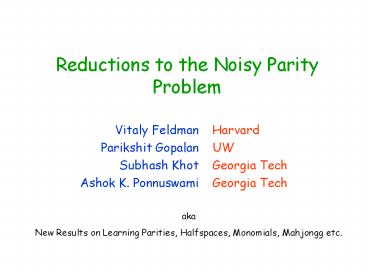Reductions to the Noisy Parity Problem - PowerPoint PPT Presentation
1 / 23
Title:
Reductions to the Noisy Parity Problem
Description:
Reductions to the Noisy Parity Problem. TexPoint fonts used in EMF. ... Main Idea: A noisy parity algorithm can help find large Fourier coefficients ... – PowerPoint PPT presentation
Number of Views:43
Avg rating:3.0/5.0
Title: Reductions to the Noisy Parity Problem
1
Reductions to the Noisy Parity Problem
- Vitaly Feldman
- Parikshit Gopalan
- Subhash Khot
- Ashok K. Ponnuswami
Harvard UW Georgia Tech Georgia Tech
aka New Results on Learning Parities, Halfspaces,
Monomials, Mahjongg etc.
TexPoint fonts used in EMF. Read the TexPoint
manual before you delete this box. AAAAAAA
2
Uniform Distribution Learning
x, f(x) x ? 0,1n f 0,1n ! 1,-1
Goal Learn the function f in poly(n) time.
3
Uniform Distribution Learning
- Goal Learn the function f in poly(n) time.
- Information theoretically impossible.
- Will assume f has nice structure, such as
- Parity f(x) (-1)?x
- Halfspace f(x) sgn(wx)
- k-junta f(x) f(xi1,,xik)
- Decision Tree
- DNF
x, f(x)
4
Uniform Distribution Learning
- Goal Learn the function f in poly(n) time.
- Parity nO(1) Gaussian elim.
- Halfspace nO(1) LP
- k-junta n0.7k MOS
- Decision Tree nlog n Fourier
- DNF nlog n Fourier
x, f(x)
5
Uniform Distribution Learning with Random Noise
x ? 0,1n f 0,1n ! 1,-1 e 1 w.p ? 0
w.p 1 - ?
x, (-1)ef(x)
Goal Learn the function f in poly(n) time.
6
Uniform Distribution Learning with Random Noise
- Goal Learn the function f in poly(n) time.
- Parity Noisy Parity
- Halfspace nO(1) BFKV
- k-junta nk Fourier
- Decision Tree nlog n Fourier
- DNF nlog n Fourier
x, (-1)ef(x)
7
The Noisy Parity Problem
Coding Theory Decoding a random linear code
from random noise. Best Known Algorithm 2n/log
n Blum-Kalai-Wasserman BKW Believed to be
hard. Variant Noisy parity of size k. Brute
force runs in time O(nk).
x, (-1)ef(x)
8
Agnostic Learning under the Uniform Distribution
x, g(x)
g(x) is a -1,1 random variable. Prxg(x) ?
f(x) ?
Goal Get an approx. to g that is as good as f.
9
Agnostic Learning under the Uniform Distribution
- Goal Get an approx. to g that is as good as f.
- If the function f is a
- Parity 2n/log n FGKP
- Halfspace nO(1) KKMS
- k-junta nk KKMS
- Decision Tree nlog n KKMS
- DNF nlog n KKMS
x, g(x)
10
Agnostic Learning of Parities
- Given g which has a large Fourier coefficient,
find it. - Coding Theory Decoding a random linear code with
adversarial noise. - If queries were allowed
- Hadamard list decoding GL, KM.
- Basis of algorithms for Decision trees KM, DNF
Jackson.
x, g(x)
11
Reductions between problems and models
Noise-free
Agnostic
Random
x, (-1)ef(x)
x, f(x)
x, g(x)
12
Reductions to Noisy Parity
- Theorem FGKP Learning Juntas, Decision Trees
and DNFs reduce to learning noisy parities of
size k.
13
Uniform Distribution Learning
- Goal Learn the function f in poly(n) time.
- Parity nO(1) Gaussian elim.
- Halfspace nO(1) LP
- k-junta n0.7k MOS
- Decision Tree nlog n Fourier
- DNF nlog n Fourier
x, f(x)
14
Reductions to Noisy Parity
- Theorem FGKP Learning Juntas, Decision Trees
and DNFs reduce to learning noisy parities of
size k.
Evidence in favor of noisy parity being
hard? Reduction holds even with random
classification noise.
15
Uniform Distribution Learning with Random Noise
- Goal Learn the function f in poly(n) time.
- Parity Noisy Parity
- Halfspace nO(1) BFKV
- k-junta nk Fourier
- Decision Tree nlog n Fourier
- DNF nlog n Fourier
x, (-1)ef(x)
16
Reductions to Noisy Parity
- Theorem FGKP Agnostically learning parity with
error-rate ? reduces to learning noisy parity
with error-rate ?. - With BKW, gives 2n/log n agnostic learning
algorithm. - Main Idea A noisy parity algorithm can help find
large Fourier coefficients from random examples.
17
Reductions between problems and models
Noise-free
Agnostic
Random
x, (-1)ef(x)
x, f(x)
x, g(x)
- Probabilistic Oracle
18
Probabilistic Oracles
Given h 0,1n ! -1,1
h
x, b
x ? 0,1n, b 2 -1,1. Eb x h(x).
19
Simulating Noisefree Oracles
Let f 0,1n ! -1,1.
f
x, f(x)
x, b
Eb x f(x) 2 -1,1, hence b f(x)
20
Simulating Random Noise
Given f 0,1n ! -1,1 and ? 0.1 Let h(x)
0.8 f(x).
0.8f
x, f(x)
x, b
Eb x 0.8 f(x) Hence b f(x) w.p 0.9 b
-f(x) w.p 0.1
21
Simulating Adversarial Noise
Given g(x) is a -1,1 r.v. and Prxg(x) ? f(x)
?. Let h(x) Eg(x).
h
x, g(x)
x, b
Bound on error rate implies Exh(x) f(x) lt ?
22
Reductions between problems and models
Noise-free
Agnostic
Random
x, (-1)ef(x)
x, f(x)
x, g(x)
- Probabilistic Oracle
23
That's it
for the slideshow.































